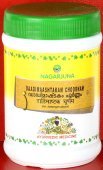Punica granatum: 3 definitions
Introduction:
Punica granatum means something in Hinduism, Sanskrit, biology. If you want to know the exact meaning, history, etymology or English translation of this term then check out the descriptions on this page. Add your comment or reference to a book if you want to contribute to this summary article.
In Hinduism
Ayurveda (science of life)
Agriculture (Krishi) and Vrikshayurveda (study of Plant life)
Source: Asian Agri-History: Drumavichitrikaranam—The Ancient Approach to Plant MutagenesisPunica granatum (Pomegranate) was used in the process of organic plant mutagenesis by ancient Indian agriculturists, which presents a safe technology and methodology regarding organic agriculture, according to treatises (such as the Vrikshayurveda). One such technology was to produce flowers and fruits on other species of plants and trees: The term drumavichitrikaranam (“plant mutagenesis”) obtains its true meaning in the literal sense through this objective. Some of them are described in the Upavanavinoda of Śārṅgadhara: such as to grow Punica granatum (pomegranate) fruits on Musa paradisiaca (plantain tree).
Source: Shodhganga: Drumavichitrikarnam—Plant mutagenesis in ancient IndiaPunica granatum (in Sanskrit: Dāḍima, Dāḍimī, Dāḍimba) is used in various bio-organical recipes for plant mutagenesis, according to the Vṛkṣāyurveda by Sūrapāla (1000 CE): an encyclopedic work dealing with the study of trees and the principles of ancient Indian agriculture.—Accordingly, “If bulbs of various species of Nymphaea are uprooted tied together firmly with threads, smeared with melted butter and honey and then planted they produce those respective species in bunches (on a single creeper). Similarly several wonders of transformation can be worked out by tying together the stems of Nerium indicum and those of various species of Punica granatum [e.g., Dāḍimī]”.

Āyurveda (आयुर्वेद, ayurveda) is a branch of Indian science dealing with medicine, herbalism, taxology, anatomy, surgery, alchemy and related topics. Traditional practice of Āyurveda in ancient India dates back to at least the first millenium BC. Literature is commonly written in Sanskrit using various poetic metres.
Biology (plants and animals)
Source: Google Books: CRC World Dictionary (Latin names; Binomial nomenclature)Punica granatum L. is the name of a plant defined in various botanical sources. This page contains potential references in modern medicine, Ayurveda, and other local traditions or folk medicine.
References regarding Punica granatum L. for further research on medicinal uses or toxicity:
· Species Plantarum (1753)
· FBI (1879)
· North American Flora (1928)
· Annals of the New York Academy of Sciences (1936)
· Ann. Cat. Vasc. Pl. W. Pakistan & Kash. (1972)
· Journal of Cytology and Genetics (1981)
· New Botanist (1981)
· Investigatio et Studium Naturae (1992)
· Regnum Vegetabile, or ‘a Series of Handbooks for the Use of Plant Taxonomists and Plant Geographers’ (1993)
· Ethnobotany (2004)
· Journal of Ethnopharmacology (2009)

This sections includes definitions from the five kingdoms of living things: Animals, Plants, Fungi, Protists and Monera. It will include both the official binomial nomenclature (scientific names usually in Latin) as well as regional spellings and variants.
See also (Relevant definitions)
Full-text (+330): Dadima, Daalimbe, Dadimba, Danimma, Dalimba, Raktabija, Dalika, Ekamuli, Malaki, Sunila, Dantabijaka, Phalashadava, Daadimba, Nallamatulai, Tuccam, Nattumatalai, Dalimma, Darimu, Pintirakacceti, Vintapurakam.
Relevant text
Search found 1 books and stories containing Punica granatum; (plurals include: Punica granatums). You can also click to the full overview containing English textual excerpts. Below are direct links for the most relevant articles:
The Markandeya Purana (by Frederick Eden Pargiter)
Related products
(+5 more products available)





